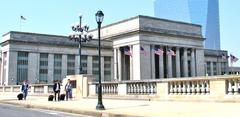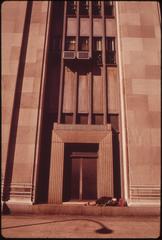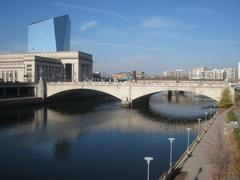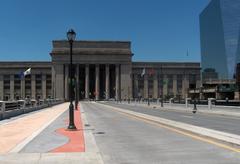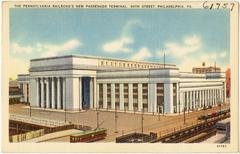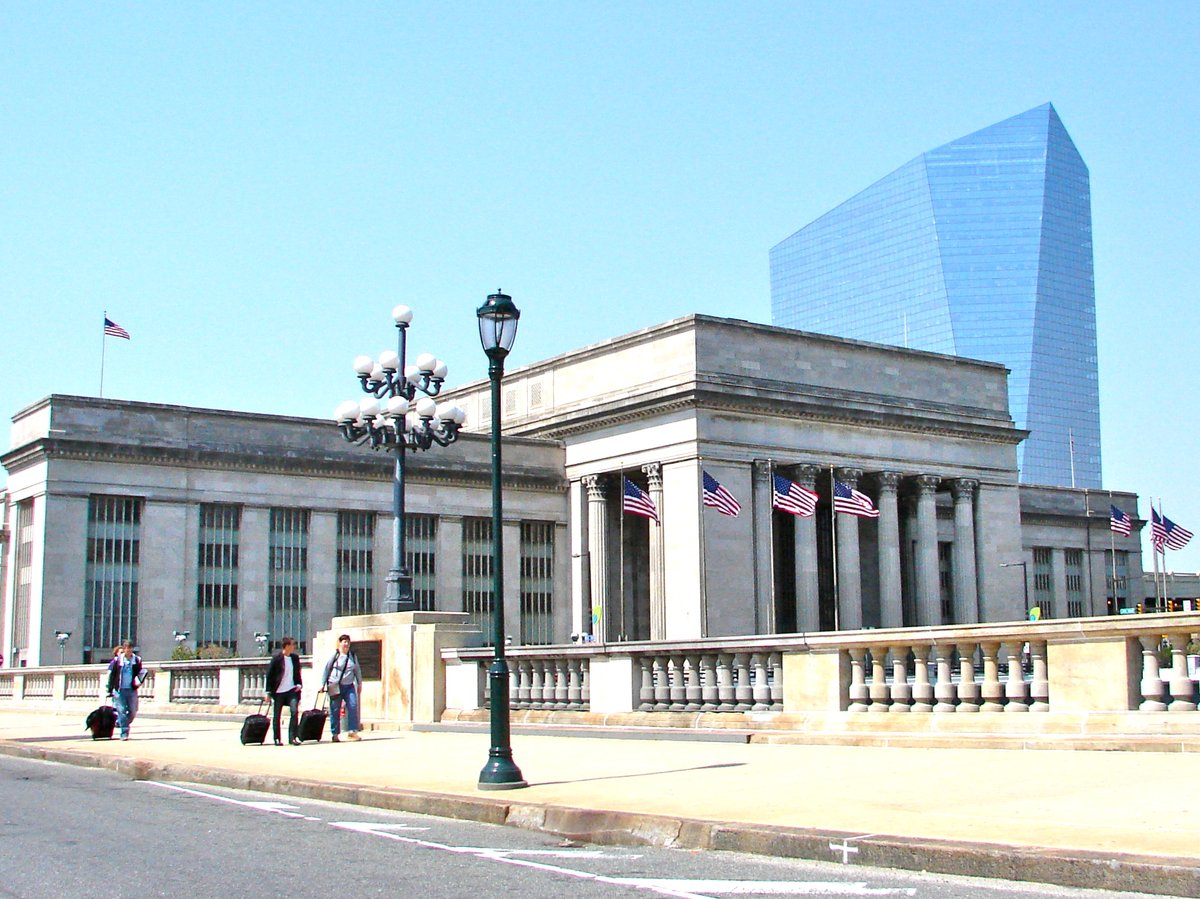
30th Street Station: Visiting Hours, Tickets, and Comprehensive Guide to Philadelphia’s Historic Transit Hub
Date: 14/06/2025
Introduction
Philadelphia’s 30th Street Station, officially the William H. Gray III 30th Street Station, is more than just a transportation center—it is an iconic landmark, a marvel of Beaux-Arts architecture, and a living monument to the city’s evolution. Opened in 1933 and designed by Graham, Anderson, Probst & White, the station’s imposing neoclassical façade, soaring concourse, and cultural memorials embody both historical significance and modern function. This guide provides essential details for visitors—covering hours, tickets, accessibility, tips, nearby attractions, and ongoing redevelopment—ensuring you experience the best of this Philadelphia treasure (Wikipedia; The Travel).
Table of Contents
- Origins and Early Development
- Architectural Highlights and Historic Features
- Role in American Transportation
- Visiting 30th Street Station: Hours, Tickets, and Accessibility
- Travel Tips and Amenities
- Nearby Attractions
- Modernization and Future Vision
- Frequently Asked Questions (FAQ)
- References
1. Origins and Early Development
30th Street Station was conceived by the Pennsylvania Railroad to unify and modernize Philadelphia’s rail operations in the early 20th century. Construction began in 1927, and the station officially opened in 1933, replacing the aging Broad Street Station. Its location in University City was strategic, serving as a bridge between Center City and major academic institutions such as the University of Pennsylvania and Drexel University (Wikipedia).
A notable innovation was the station’s design to accommodate electrified rail, allowing trains to pass beneath the main concourse, shielding travelers from the smoke and grit of steam engines—a forward-thinking move that set new standards in passenger comfort and efficiency (Wikipedia).
2. Architectural Highlights and Historic Features
Beaux-Arts Grandeur
The station’s limestone-clad exterior, with columned porticos and monumental symmetry, exemplifies the Beaux-Arts style, echoing the dignity and permanence of classical antiquity (SAH Archipedia; EAA). Inside, the main concourse—often called the “cathedral of transportation”—features:
- Eighteen Corinthian columns
- A 95-foot coffered ceiling illuminated by massive chandeliers
- Tennessee marble floors and walls
- Art Deco decorative elements and bronze inscriptions
Historic and Memorial Features
A poignant focal point is the Pennsylvania Railroad World War II Memorial, a 39-foot bronze statue of Archangel Michael lifting a fallen soldier, honoring the 1,307 PRR employees who lost their lives in WWII (The Travel; SAH Archipedia). The station originally included amenities like a chapel, mortuary, and hospital facilities—a reflection of the expansive vision for public transit in the early 20th century (EAA).
3. Role in American Transportation
30th Street Station quickly established itself as a key node in the national rail network. It became Philadelphia’s primary intercity rail terminal after the closure of the Baltimore and Ohio Railroad’s Chestnut Street station in 1958 (Wikipedia). Today, it is:
- The third-busiest Amtrak station nationwide (over 4 million passengers in 2023)
- Busiest in Pennsylvania
- A hub for Amtrak’s Northeast Corridor, SEPTA Regional Rail, and NJ Transit’s Atlantic City Line
Its strategic connections make it an indispensable part of travel in the Northeast and Mid-Atlantic (Railway Age).
4. Visiting 30th Street Station: Hours, Tickets, and Accessibility
Visiting Hours
- Main Concourse: Open daily, typically from 5:00 AM to 12:00 AM (some services extend to 1:00 AM; check Amtrak for updates).
- Ticket Counters: Generally open from 5:00 AM to 10:00 PM.
- Retail and Dining: Hours vary by vendor, especially during ongoing renovations (PhillyVoice).
Ticketing
- Amtrak: Purchase online, via the Amtrak app, at station counters, or kiosks.
- SEPTA & NJ Transit: Tickets available at dedicated machines, counters, or via mobile apps.
Accessibility
The station is fully ADA-compliant, with ramps, elevators, accessible restrooms, and assistance services. Visual and audible announcements provide inclusivity for all travelers (Amtrak).
5. Travel Tips and Amenities
- Best Times to Visit: Weekdays between morning and evening rush hours are less crowded.
- Navigation: Station maps are available at entrances; digital displays aid wayfinding.
- Baggage: Luggage carts and checked baggage services are available for select routes.
- WiFi: Free WiFi is offered throughout, with charging stations in waiting areas.
- Restrooms: Located near food courts and the North Waiting Room.
- Parking: Multiple short- and long-term options nearby; pre-booking is recommended.
During renovations (through 2025): Food and retail options are limited, with Dunkin’ (24/7), Pret A Manger kiosks, vending machines, and Garces Trading Co. in the nearby Cira Centre available (PhillyVoice). For more variety, explore University City or Center City.
6. Nearby Attractions
- University City: Drexel University and University of Pennsylvania campuses are adjacent.
- Schuylkill River Trail: Ideal for walking or biking, just steps from the station.
- Philadelphia Museum of Art: Less than a mile away.
- Cira Green: An elevated park with city views.
- Reading Terminal Market: 1.3 miles away, renowned for food and local culture.
The Porch at 30th Street Station offers outdoor seating, food trucks, and live performances during warmer months.
7. Modernization and Future Vision
The 30th Street Station District Plan is transforming the station and its surroundings into a world-class transit and civic hub. This $10 billion redevelopment includes:
- New Market Street Plaza and expanded public spaces
- Modernized ticketing, baggage, and waiting areas
- Up to 20 new retail and dining venues
- Enhanced accessibility and sustainability features
- Integration with new mixed-use developments atop adjacent rail yards (SOM)
A 50-year public-private partnership between Amtrak and Plenary Infrastructure Philadelphia ensures ongoing stewardship, accessibility, and resilience (Gray 30th Street Station; Philadelphia Today).
8. Frequently Asked Questions (FAQ)
Q: What are the current visiting hours for 30th Street Station?
A: Main concourse is open from 5:00 AM to midnight (with some services until 1:00 AM). Retail hours vary.
Q: How can I buy train tickets?
A: Purchase tickets online (Amtrak, SEPTA, NJ Transit), via mobile apps, at ticket counters, or kiosks.
Q: Is the station fully accessible?
A: Yes, elevators, ramps, accessible restrooms, and assistance services are provided.
Q: Is there parking onsite?
A: Yes, both short-term and long-term parking are available. Pre-book for best rates.
Q: Are guided tours available?
A: Regular guided tours are not offered, but special events may include them. Check Gray 30th Street Station for updates.
Q: What are recommended nearby attractions?
A: University City, the Philadelphia Museum of Art, Schuylkill River Trail, and The Porch at 30th Street Station.
9. References
- Wikipedia
- The Travel
- EAA
- SAH Archipedia
- Railway Age
- PhillyVoice
- Amtrak
- PureHistory
- Gray 30th Street Station
- SOM
- Philadelphia Today
- City Cast Philly
- Transportation Summit
- Arora Engineers
Summary
30th Street Station stands as a testament to Philadelphia’s enduring legacy of innovation, culture, and architecture. With its blend of historical grandeur and ongoing modernization, the station is not only a vital transit hub but also a destination in itself. Whether you’re catching a train, admiring its architectural beauty, or exploring nearby neighborhoods and attractions, 30th Street Station offers a dynamic experience at the heart of Philadelphia.
Plan your visit with confidence by using official resources, downloading travel apps, and staying updated on station events and renovations. For more information, consult the referenced sources and follow station updates online.

